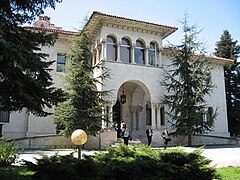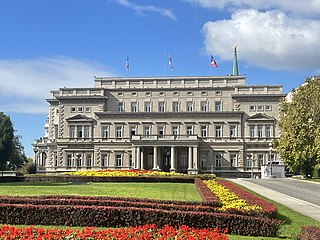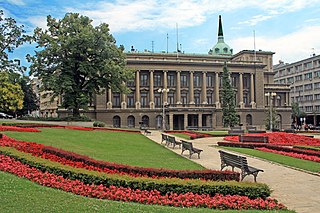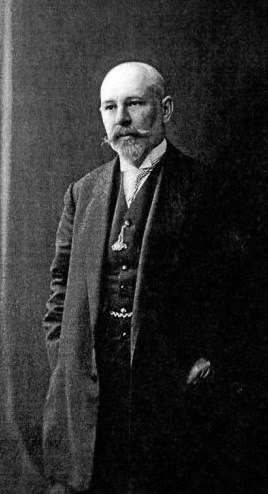This article lists Serbian former royal official and private residences.
Contents


This article lists Serbian former royal official and private residences.



Alexander, Crown Prince of Yugoslavia, is the head of the House of Karađorđević, the former royal house of the defunct Kingdom of Yugoslavia and its predecessor the Kingdom of Serbia. Alexander is the only child of King Peter II and his wife, Princess Alexandra of Greece and Denmark. He held the position of crown prince in the Democratic Federal Yugoslavia for the first four-and-a-half months of his life, until the declaration of the Federal People's Republic of Yugoslavia later in November 1945, when the monarchy was abolished. In public he claims the crowned royal title of "Alexander II Karadjordjevic" as a pretender to the throne.

The Beli Dvor is one of two residences of the Dedinje Royal Compound in the Dedinje neighborhood of Belgrade. It was the official residence of the Prince Regent Paul from 1934 to 1941.

Bačka Topola is a town and municipality located in the North Bačka District of the autonomous province of Vojvodina, Serbia. The municipality is composed of 23 local communities and has a population of 33,321, while the town itself has 14,573 inhabitants.

Dedinje is an urban neighborhood of Belgrade, the capital of Serbia. It is located in Belgrade's municipality of Savski Venac. Dedinje is generally considered the wealthiest part of Belgrade, and is the site of numerous villas and mansions owned by the members of the city's plutocracy, as well as many diplomatic residences.

Topola is a town and municipality located in the Šumadija District of central Serbia. It was the place where Karađorđe, a Serbian revolutionary, was chosen as the leader of the First Serbian Uprising against the Ottoman Empire in 1804. The local St. George Church is the burial place of the Ducal and Royal Family of Serbia and Yugoslavia.

Stari Dvor is the city hall of Belgrade, Serbia, housing the office of the Mayor and the City Assembly. It was the royal residence of Serbian royal family from 1884 to 1922. The palace is located on the corner of Kralja Milana and Dragoslava Jovanovića streets, opposite Novi Dvor.
White Palace may refer to:
The Dedinje Royal Compound is a complex of former royal residences commissioned by and built with the personal funds of King Alexander I in the Dedinje neighborhood of Belgrade, Serbia, between 1924 and 1937.
Kraljevski Apartman is a Serbian heavy metal band from Belgrade. The band rose to prominence during the late 1990s and early 2000s, becoming one of the most popular bands on the Serbian heavy metal scene.

Andrićev Venac is a street and the surrounding urban neighborhood of Belgrade, the capital of Serbia. It is located in Belgrade's municipality of Stari Grad. As the official seat of the President of Serbia is located in it, it became synonymous for the politics of the president.

Architecture of Belgrade is the architecture and styles developed in Belgrade, Serbia. Belgrade has wildly varying architecture, from the centre of Zemun, typical of a Central European town, to the more modern architecture and spacious layout of New Belgrade. The oldest architecture is found in Kalemegdan park. Outside of Kalemegdan, the oldest buildings date only from 19th century, due to its geographic position and frequent wars and destructions. The oldest public structure in Belgrade is a nondescript Turkish türbe, while the oldest house is a modest clay house on Dorcol, the House at 10 Cara Dušana Street from 1727.

The Kraljevski Dvor is the main building in the Dedinje Royal Compound and was the official residence of the Karađorđević royal family from 1934 to 1941. The palace was built between 1924 and 1929 with the private funds of King Alexander I and since 2001 is home of Crown Prince Alexander.

The Novi Dvor is the seat of the President of Serbia. It was a royal residence of the Karađorđević dynasty of Kingdom of Yugoslavia from 1922 to 1934. The palace is located on Andrićev Venac in Belgrade, Serbia, opposite Stari Dvor.

Nikolay Petrovich Krasnov was a Russian Serbian architect and painter, who served as Chief Architect of Yalta, Crimea, between 1887 and 1899. From 1922 he lived and worked in the Kingdom of Yugoslavia, and was a key figure in the architectural development of Belgrade.

Park Aleksandrov is a park in Belgrade, a capital of Serbia. It is situated in the sole center of the city, along the main Kralja Milana street. Named Devojački Park until 2017, it is located in the municipality of Stari Grad.

Pioneers Park is a park in Belgrade, the capital of Serbia. Developed from the royal garden, which itself was a successor of a much older garden, it is today one of the central city parks. It has been open for public since 1944. The park has been declared a botanical natural monument.

The Guard of the Serbian Armed Forces is an honour guard unit of the Serbian Armed Forces under the direct command of the General Staff. Besides ceremonial duties its main tasks include security and logistics missions.

The Villa Zlatni Breg, also known as the Obrenović Summerhouse, in Smederevo, Serbia, is state representation house, owned and managed by the Serbian state. It was a private residence and summer retreat of the royal house of Obrenović from 1865 to 1903. The earliest structure originates from 1865 but was expanded and reconstructed several times since then. As it is owned by the state, it has been used for the state receptions and since 2015 is open for public.